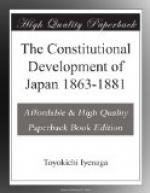I remarked in the beginning that the political activity of a nation is not isolated from other spheres of its activities, but that there is a mutual interchange of action and reaction among the different factors of social life, so that to trace the political life of a nation it is not only necessary to describe the organ through which it acts, the governmental machinery, and the methods by which it is worked, but to know “the forces which move it and direct its course.” Now these forces are political as well as non-political. This truth is now generally acknowledged by constitutional writers. Thus, the English author of “The American Commonwealth” devotes over one-third of his second volume to the account of non-political institutions, and says “there are certain non-political institutions, certain aspects of society, certain intellectual or spiritual forces which count for so much in the total life of the country, in the total impression it makes and the hopes for the future which it raises, that they cannot be left unnoticed."[1]
If this be the case in the study of the American commonwealth, it is more so in that of Japanese politics. For nowhere else in the history of nations do we see “non-political institutions” exerting such a powerful influence upon the body politic as in New Japan. In this chapter we shall therefore note briefly the growth of so-called “non-political institutions” during a period of about a decade and a half, between 1868 and 1881, and mark their influence upon the development of representative ideas.
I.—MEANS OF COMMUNICATION.
1. Telegraph. At the time of the Restoration there was no telegraph in operation, and “for expresses the only available means were men and horses.” In 1868 the government began to construct telegraphs, and the report of the Bureau of Statistics in 1881 shows the following increase in each successive year:
Telegraph
Number
Year. Offices. Miles.
of Telegrams.
Ri
Cho.
1869-1871 8 26.04 19,448
1872 29 33.11 80,639
1873 40 1,099.00 186,448
1874 57 1,333.20 356,539
1875 94 1,904.32 611,866
1876 100 2,214.07 680,939
1877 122 2,827.08 1,045,442
1878 147 3,380.05 1,272,756
1879 195 3,842.31 1,935,320
1880 195 4,484.30 2,168,201




